Life inside a Yellow-Face (Hylaeus communis) solitary bee nest
This lovely cavity-nesting superficially wasp-like bees can very easily be overlooked as they are tiny, (4-5mm). I have had them foraging in the garden, but to my knowledge never had them nest. I did n’t know what they required. Hence I set out to attempt to attract them to nest in one of my nest boxes. This species is Hylaeus communis or common yellow-face bee. Although Falk states that it is the main Hylaeus species to utilise garden bee hotels, it took me a few seasons to get their nesting requirements right, so you can imagine how pleased I was when I attracted several of them to nest in my solitary bee nest box which I later incorporated into the design of my new summer unit.
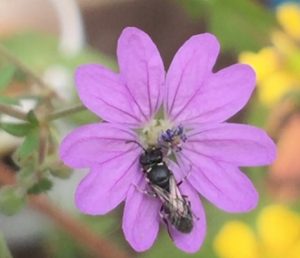
Yellow Face Bee on Hedgerow Cranesbill
Cavity-nesting plasterer bees
These cavity-nesting bees are predominantly black and almost hairless, with triangular yellow markings on their face. They are known as plasterer bees, (colletids) and the film shows why. The female does n’t have pollen baskets on her hind legs or even a scopa under her abdomen, which many other cavity-nesting solitary bees use to store pollen when foraging. Instead, they carry the pollen internally in their crop and mix it with nectar which they regurgitate inside the nest cavity.
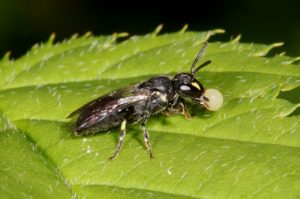
Yellow-face bee blowing nectar bubbles to concentrate nectar
The bubble blowing bees
Nectar contains water. These bees blow out nectar bubbles and suck them back in again to evaporate the water, known as water homeostasis. This concentrates and thickens the nectar/pollen mixture making it tacky like honey. You can see how fluid this mixture is and how the eggs and even the larvae ‘stick’ to its surface, unlike many other solitary bee larvae which ‘sit’ on top of the more solid pollen mixture. The concentrated liquid brood mass requires the larvae to ‘swim’ across it doing a kind of side stroke, something that is unique to plasterer bees. You will see that the larvae, as filmed, are a distinct “C” shape as they float on the tacky liquid surface.
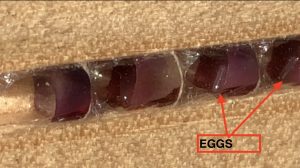
Yellow-face bee eggs ‘stuck’ to concentrated pollen/nectar mix
Paintbrush-like tongue
You will see that these bees do not use the same materials as several other cavity-nesting solitary bees, e.g. mud for Red masons or leaf pieces for leafcutter bees which they physically carry to their nest. Instead, she uses her ‘brush-like’ tongue (glossa) to paint and ‘plaster’ the saliva/mixture material drawing it out to form a waterproof cellophane-like membrane on the roof, walls and floor. As these bees nest mainly inside plant material/wood cavities, I suspect the lining would need to contain antibacterial and/or anti-fungicidal substances in it. She clearly deposits something from a gland (Dufour’s gland) at the rear of her abdomen, turns around, and spreads the drops over the already laid saliva mix. Torchio et al, describe the first-ever observation of this exact action from a Colletid bee species in 1988. This continues layer upon layer to form the cell membrane. I noted that the ends of the nest cavity were dabbed with the rear of her abdomen many times, depositing a liquid before mixing with saliva and painting the rest of the cell.
Purple and green nectar updated film
There were two distinct nectar/pollen mixtures used by different females, a purplish and a green. It looked that each female showed a preference for a particular flower which she used over and over again when foraging. Each female stuck to her choice within each cavity throughout the whole nesting period, implying that they were constant to one floral host plant over the nesting period. I never saw a purple brood cell in any of the green cavities and vice versa. The liquid forage inside the cell would need a waterproof lining to keep it inside the brood cells or it would leach out. Being non-permeable also stops moisture entering the cells and contaminating the food. Other colletid bees use cellophane to waterproof their brood cells in the underground keeping them waterproof in floods.
Foraging trips
Just imagine for one minute the volume and weight of the nectar mixture inside one brood cell. How many tiny drops were collected, how many trips this would take and the extra weight of it as it was being transported. This is no mean feat!
Wide flower choice
Having such an unusual shaped tongue in that it looks short and wide, (dare I say like a paintbrush?!) and the small size of the bee itself I suspect would limit the pollen/nectar that these bees could gather. To compensate for this, makes me think that they would need a wide range of many different flower species that had easily accessible forage for them to gather. It was actually difficult to determine what they were gathering from the flowers I managed to see them visit as many of these visits were fleeting visits, except for example orange hawkweed (Pilosella aurantiaca).
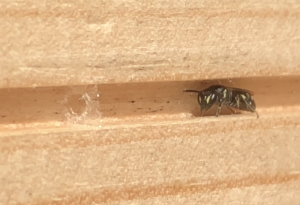
Female Hylaeus sp. Yellow-Face bee with just one of the several portals she made
Portals as temporary vertical stores
I particularly liked the way each female made several ‘portal-like structures’, inside her chosen cavity before foraging and laying an egg. You can clearly see that once a portal was made, she would deposit material on it from her Dufour gland then draw it out with her abdomen, forming a latticework of strands and layers, similar to the end cell walls filmed and spread it with her tongue adding saliva to the mix. The portal is much more solid and sturdier than the cellophane nest lining. It has to be as she will go inside and exit the portals many times a day. The portal is the first stage of a cell cap. It is also used as a temporary ‘vertical store’ for secretions, as she neared a cell completion, in preparation for completing and sealing the next new cell in front of the portal. The old cell portal is sealed up using the wall of the portal and deposits she made a short time earlier by adding new saliva material and sealing the portal hole itself. A more detailed film of this process will be done in the future.
Fibrous Portal holes
The actual hole into the circular portal had numerous varying sized rough strands of a fibre-like substance on both sides of the hole. It looks similar to rough silk strands, to be honest. This would give the bee a foundation to draw the freshly deposited mesh-like strands over the portal hole to seal it. Like zipping up a tent! It may well save her a lot of time having a solid substance (portal wall) to temporarily deposit nest lining substances from her rear just prior to sealing it up with her tongue, as they did when they used the cell side walls, roof and floor.
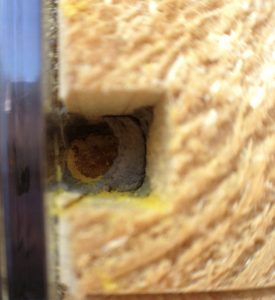
Red Mason bees do a similar thing with their mud cells although they only partially build the mud partition wall, prior to completely sealing it, as above, similar in shape to the cellophane portal, carry on depositing forage, lay their egg and seal the cavity with mud. The Yellow-face bees made several portals in advance before foraging.
Cell walls
The transparent lining has remained transparent, shiny and very smooth and looks like a piece of cling film has been placed over the larvae for overwintering!
Pests
Luckily for all these females none of their nests had been sought out by one of their main parasitic wasps, the Gasteruption genus with their extremely long ovipositor.
N. America
It looks like this tiny bee has somehow found its way to N. America. One thing is for certain, it did not fly!
Film interpretation
Its funny really, making the film and seeing the bees at work, although being rather blind as to what interpretation to make of the bees and their actions! I know a little more now!
Many thanks to Prof Ted Benton for the bubble blowing bee photograph, Dr Jim Cane, (USDA) and Prof Bryan Danforth (Cornell University) for their help in translating the actions of the bees in the film and other information (pers comm) and
Want to observe solitary bees in more detail? See my solitary bee observation nest box.
For more information about solitary bees see BWARS
For info and link to buy an excellent book Field Guide to the Bees of Great Britain and Ireland by Steven Falk
An extremely useful resource supports this book by a special website feature within Steve Falk’s Flickr website which furnishes extra photos and other useful resources to assist with identification.
Solitary Bees book by Ted Benton
Interested in Citizen Science and pollinators? (e.g. bees!) The Buzz Club

Thanks – this is great – clear explanations and detail, + amazing video
Thanks, Zaph, I found it fascinating, something 100% I did not know about. Cheers, George